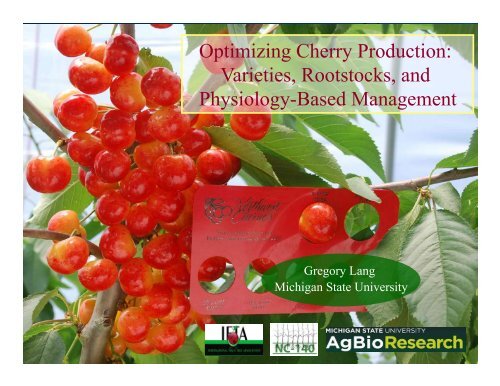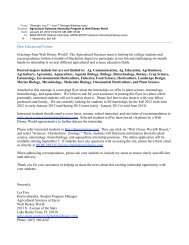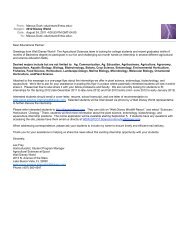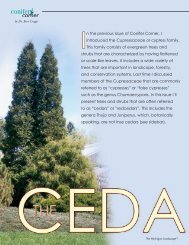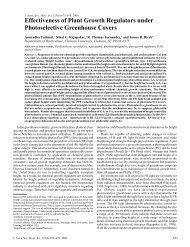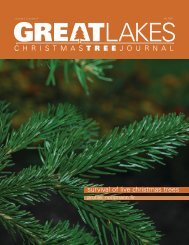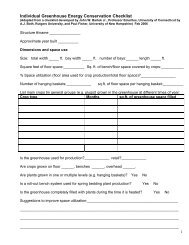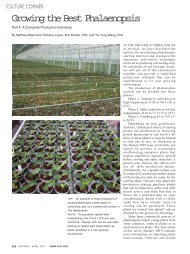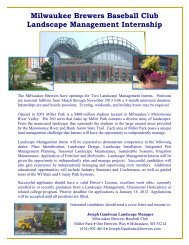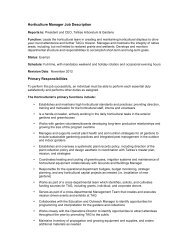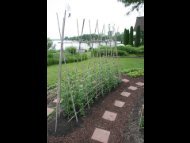Optimizing Cherry Production - Michigan State University
Optimizing Cherry Production - Michigan State University
Optimizing Cherry Production - Michigan State University
Create successful ePaper yourself
Turn your PDF publications into a flip-book with our unique Google optimized e-Paper software.
<strong>Optimizing</strong> <strong>Cherry</strong> <strong>Production</strong>:<br />
Varieties, Rootstocks, and<br />
Physiology-Based Management<br />
Gregory Lang<br />
<strong>Michigan</strong> <strong>State</strong> <strong>University</strong>
U.S. <strong>Cherry</strong> <strong>Production</strong> 2001<br />
#2: WA 26,000<br />
acres<br />
#4: OR 11,000<br />
acres<br />
Total <strong>Cherry</strong> Acreage 1<br />
#1: MI 35,000<br />
acres<br />
#3: CA 25,000<br />
acres<br />
#5: UT 3,500<br />
acres<br />
1<br />
USDA, 1999-2001
U.S. <strong>Cherry</strong> <strong>Production</strong> 2011<br />
#1: WA 35,600<br />
acres<br />
#4: OR 13,150<br />
acres<br />
Total <strong>Cherry</strong> Acreage 1<br />
#2: MI 33,000<br />
acres<br />
#3: CA 29,000<br />
acres<br />
#5: UT 3,800<br />
acres<br />
1<br />
USDA, 2009-2011
2011 Sweet <strong>Cherry</strong> Acreage<br />
#1: WA 34,000<br />
acres<br />
#3: OR 12,500<br />
acres<br />
Sweet <strong>Cherry</strong> Acreage 1<br />
#5: ID<br />
900 acres<br />
#4: MI 6,500<br />
acres<br />
#2: CA 29,000<br />
acres<br />
1<br />
USDA, 2009-2011
Globally Competitive <strong>Production</strong> through<br />
Advanced Germplasm, Technologies, and<br />
Physiology-Based <strong>Production</strong> Knowledge
Rain Covers<br />
in Chile
Rain Covers in Norway
Rain Covers in Switzerland
Semi-Mechanical Rain<br />
Covers in Netherlands<br />
Hand-pull covers<br />
Crank-down covers
Vented Covers (VOEN) in Germany, Italy, Switzerland<br />
- Protection from rain and hail; passive venting of heat in summer
High Tunnels (Haygrove) in the United Kingdom<br />
- Protection from rain, hail, and wind; greater heat retention in spring
High Tunnels in the United <strong>State</strong>s<br />
- Protect from rain, hail, wind, frost; reduce<br />
some diseases, and promote earlier ripening
Chinese structures<br />
range from<br />
bamboo tunnels to<br />
28 ft high steel<br />
greenhouses<br />
Half-Tunnels in China
High Tunnels in Norway
“World’s Most Expensive<br />
Cherries” $35 to $150 per kg<br />
Greenhouse Cherries in Spain<br />
- Promote early harvest for high<br />
value, off-season markets
Computer-Programmable Retractable Roof (Cravo)
Roof Panels Open and Close in Response to Rain, Wind, and High<br />
and Low Temperature Set-Points to Optimize Growing Conditions
2011 Research: 80,000 BTU Propane Heaters, every 100 ft,<br />
added ~6°F when outside temperatures were 17 to 27°F
Chelan<br />
• Parents: Stella x Beaulieu<br />
• Early ripening, 10-12 days before Bing<br />
• Precocious, moderately upright, highly<br />
productive tree (rootstocks, stress)<br />
• Less rain cracking than Bing<br />
• Graft incompatible w/<br />
mahaleb, sensitive to<br />
stress, limb-bending?
Santina<br />
• Parents: Stella x Summit<br />
• Self-fertile<br />
• Firm, large size<br />
• Blooms mid-season, ripens 8<br />
days before Bing<br />
• Moderately tolerant to rain<br />
cracking
Cornell Stone Fruit<br />
BlackPearl® NY 8139<br />
BlackPearl is the best cherry it's<br />
season, ripening 10 days before<br />
Bing, with Chelan. (-10) It has<br />
exceptional flavor and is<br />
extremely firm and crunchy. The<br />
fruit is medium size with 20%<br />
sugar. BlackPearl has amazing<br />
storage qualities and keeps<br />
better than almost any other<br />
cherry. It is hardy and canker<br />
resistant with low cracking. Early<br />
season bloom,<br />
S4 unknown.<br />
Cornell Stone Fruit selections are a group of sweet and sour cherry,<br />
peach, plum and apricot varieties that were bred at the New York <strong>State</strong><br />
Agricultural Experiment Station in Geneva, NY; a part of Cornell <strong>University</strong>.<br />
10 Sweet cherries and 6 plums have been released from this program<br />
to date, with more to follow. They are licensed to nurseries in the
Cornell Stone Fruit<br />
RadiancePearl NY 7679<br />
RadiancePearl is a Rainier type cherry that ripens 7 to 10 days ahead<br />
of Bing (-7-10) and has exceptional flavor and quality. The fruit averages<br />
11g with 20% sugar and has exceptional flavor and low rain cracking. It<br />
has a vigorous, hardy and productive tree. RadiancePearl has an<br />
early mid-season bloom, S1 Unknown. It is perfect for fresh market and<br />
u-pick operations.<br />
Cornell Stone Fruit selections are a group of sweet and sour cherry,<br />
peach, plum and apricot varieties that were bred at the New York <strong>State</strong><br />
Agricultural Experiment Station in Geneva, NY; a part of Cornell <strong>University</strong>.<br />
10 Sweet cherries and 6 plums have been released from this program<br />
to date, with more to follow. They are licensed to nurseries in the
Tieton<br />
• Firm, very large fruit (11-13 g, 28-32<br />
mm), excellent stems, early season<br />
premium<br />
• Blooms mid-season, ripens 6-8 days<br />
before `Bing’, incompatible with<br />
`Chelan’, `Burlat’<br />
• Very vigorous, upright growth, light to<br />
moderate cropping, well-suited to<br />
dwarfing rootstocks (i.e., Gisela 5)
Cornell Stone Fruit<br />
BurgundyPearl NY 38L<br />
A large, high quality, very firm, crack resistant cherry with a tough,<br />
grower friendly tree. BurgundyPearl ripens 3 to 5 days before Bing. (-3)<br />
It has large, firm, crunchy, 12g fruit with 20.5% sugar. The tree is<br />
vigorous, productive, and canker resistant . BurgundyPearl has superior<br />
quality, storability and excellent crack resistance, averaging 4% cracking<br />
with 1” of rain in 2008. Early midseason bloom,S3S4<br />
Cornell Stone Fruit selections are a group of sweet and sour cherry,<br />
peach, plum and apricot varieties that were bred at the New York <strong>State</strong><br />
Agricultural Experiment Station in Geneva, NY; a part of Cornell <strong>University</strong>.<br />
10 Sweet cherries and 6 plums have been released from this program<br />
to date, with more to follow. They are licensed to nurseries in the
Cornell Stone Fruit<br />
EbonyPearl NY 32<br />
EbonyPearl is a large, very high quality cherry that ripens 3 days ahead<br />
of Bing. (-3) It has excellent crack resistance, averaging 4% cracking<br />
with 1” of rain in 2008. The tree is hardy, vigorous and canker resistant .<br />
Very large fruit averages 9.5 row, 11.6g with exceptional flavor and<br />
quality and has long, firmly attached stems. EbonyPearl has a early mid<br />
-season bloom. S1S4.<br />
Cornell Stone Fruit selections are a group of sweet and sour cherry,<br />
peach, plum and apricot varieties that were bred at the New York <strong>State</strong><br />
Agricultural Experiment Station in Geneva, NY; a part of Cornell <strong>University</strong>.<br />
10 Sweet cherries and 6 plums have been released from this pro-
Benton (Columbia)<br />
• Parents: Stella x Beaulieu<br />
• Self-fertile<br />
• Firm, large fruit size<br />
• High sugar, excellent flavor<br />
• Blooms late, ripens with Bing<br />
• Excellent cropping, moderately<br />
spreading growth habit<br />
• Less susceptible to rain cracking
• Precocious, spreading growth habit<br />
Sandra Rose<br />
• Blooms mid-season, ripens 3 days after Bing<br />
• Tolerant to rain cracking<br />
• Parents: (Star x Van) x<br />
Sunburst<br />
• Medium firm, large fruit<br />
size<br />
• Self-fertile
Kordia (Attika)<br />
• From Czechoslovakia<br />
• Blooms late, ripens 10 days after Bing, not selffertile<br />
• Vigorous and productive tree<br />
• Very firm, large, heartshaped<br />
fruit, excellent<br />
flavor<br />
• Less susceptible to rain cracking; more to frost<br />
• Compatible with Van, Stella, Hedelfingen, Sam,<br />
Lambert
Skeena<br />
• Parents: (Bing x Stella) x<br />
(Van x Stella)<br />
• Very firm, large fruit size<br />
• Self-fertile<br />
• Blooms mid-season, ripens 15<br />
days after Bing<br />
• Very susceptible to rain<br />
cracking (not “tolerant”)<br />
• Precocious, spreading growth<br />
habit
Rootstock Traits<br />
Vigor – high, semi-vigorous,<br />
dwarfing, or very dwarfing<br />
Precocity – early flowering,<br />
high productivity<br />
Adaptation to Soil Conditions – silty loam, sandy (welldrained,<br />
quick to dry, warm) or heavy clay (wet, prone to<br />
Phytophthora, cold in spring)<br />
Adaptation to Climatic Conditions – temperate/moderate;<br />
hot, sunny, and/or windy with high daily water demand;<br />
cool and cloudy with less photosynthesis
Precocity and the Basic <strong>Cherry</strong><br />
Fruiting Units<br />
2-Yr-old growth<br />
Last year’s growth<br />
New growth<br />
Fruiting spurs<br />
A few nonspur fruit<br />
Non-fruiting spurs<br />
Larger leaves<br />
Ayala and Lang, 2004<br />
The first fruit to appear on trees on precocious rootstocks<br />
are spur fruit on the leader (trunk) and nonspur fruit on<br />
the first lateral shoots (branches)
Erdi V.<br />
MxM 60<br />
Mah<br />
MxM 2<br />
P.50<br />
Maz<br />
CT 2753<br />
CT 500<br />
W.13<br />
W.158<br />
W.10<br />
Gi.6<br />
Gi.195/20<br />
Gi.7<br />
W.53<br />
W.72<br />
Gi.5<br />
Edabriz<br />
Gi.209/1<br />
Rootstock Influence on Cropping in Early Years<br />
Hedelfingen NC-140<br />
<strong>Michigan</strong> spring 2000 (3rd Year)<br />
0.00 0.50 1.00 1.50 2.00 2.50 3.00<br />
Blossom Clusters / cm 2*
Gisela 6<br />
Gisela 5 Gisela 6<br />
Gisela 5
High Vigor, Low Precocity Rootstocks<br />
Mazzard (Prunus avium)<br />
- seedling<br />
- F12/1, Charger, others<br />
Mahaleb (Prunus mahaleb)<br />
- seedling<br />
- SL64, SL405<br />
- CT500, CT 2753, Korponay, others<br />
MxM series (Mazzard x Mahaleb)<br />
- 2, 14 (MaxMa 14), 39, 60<br />
- Colt: Mazzard x P. pseudocerasus
NC-140 Rootstock Research<br />
- The NC-140 Rootstock Research Project is ~30<br />
scientists across N. America (US, Canada, Mexico)<br />
- NC-140 Project evaluates rootstock performance in many climates<br />
and soils, characterizing productivity, disease susceptibility, etc.<br />
Virus<br />
Testing<br />
* * *<br />
* * *
Gisela Hybrid Rootstock Series,<br />
Giessen, Germany<br />
1987/1998 NC140 Trial<br />
- Gisela 1 (172-9)*<br />
- Gisela 3 (209-1)<br />
- Gisela 4 (473-10)*<br />
- Gisela 5 (148-2)<br />
- Gisela 6 (148-1)<br />
- Gisela 7 (148-8)*<br />
- Gisela 8 (148-9)*<br />
Werner Gruppe<br />
Justus Liebig <strong>University</strong><br />
- Hanna Schmidt<br />
- Sabina Franken-Bembenek<br />
Sweet or sour cherry x<br />
P. canescens or P. fruticosa<br />
- Gisela 10 (173-9)* 318-17, 154-4*, 154-7*<br />
- Gisela 11 (195-1)* 169-15, 196-4, 148-20<br />
- Gisela 12 (195-2) 195-20*
Other Somewhat Dwarfing Hybrids<br />
Gembloux (Belgium):<br />
- Inmil (GM 9)*: incisa x serrulata<br />
- Damil (GM 61-1): Prunus dawykensis<br />
- Camil (GM 79)*: Prunus canescens<br />
Krymsk 5*, 6*, others (Russia)<br />
PiKu 1, 3, 4, others – sweet cherry x canescens,<br />
tomentosa, kurilensis, pseudocerasus, incisa (Germany)<br />
P-HL A, B, C (sweet cherry x sour cherry) (Czech)
Rootstocks Based on Sour <strong>Cherry</strong><br />
- Stockton Morello<br />
- CAB6P, others (Bologna, Italy)<br />
- Tabel Edabriz (France)<br />
- Weiroot 10*, 13*, 53*, 72, 154*, 158 (Germany)<br />
- <strong>Michigan</strong> <strong>State</strong> <strong>University</strong> series (some are sour<br />
cherry x canescens): still experimental
MSU <strong>Cherry</strong> Rootstocks - Vigor<br />
~13 years research on sour cherry-based candidates (Began with ~96 genotypes,<br />
screened for virus sensitivity, propagation, graft compatibility); currently 9<br />
genotypes, most sucker profusely. Key traits: precocity, range in size from Gi5 to<br />
somewhat smaller than Gi6, lower flower numbers<br />
Iezzoni, Whiting
Management for Success<br />
with New Rootstocks<br />
Match light-bearing,<br />
vigorous cultivars like<br />
Tieton and Regina to<br />
dwarfing productive<br />
rootstocks like Gi 5 or 12<br />
Match highly-productive<br />
cultivars like Sweetheart to<br />
more vigorous rootstocks<br />
like Colt
Do Dwarfing Rootstocks Yield Small Fruit?<br />
Rainier / Gisela 7 - Bud Thinning, Yield, Fruit Quality<br />
Total Yield<br />
Control<br />
8.7<br />
7.6<br />
16.1 mt/ha<br />
3 buds/spur<br />
6.5 10.9<br />
17.4 mt/ha<br />
2 buds/spur<br />
1 bud/spur<br />
3.2 12.0 15.2 mt/ha<br />
2.2 10.9 13.1 mt/ha<br />
Lang and Whiting, 1999
Fertilization:<br />
Focus on Producing<br />
Fruit, not Trees
Nitrogen Fertilization Strategies:<br />
Demands and Sources<br />
WHEN is Nitrogen most needed during<br />
the cherry tree’s development cycle?<br />
e.g., bloom, leaf expansion, fruit set, fruit growth, shoot<br />
elongation, root growth, flower bud formation, cold acclimation?<br />
WHERE does the Nitrogen needed for these plant<br />
demands come from - soil uptake vs. tissue storage?<br />
WHAT application forms are best to optimize N use<br />
efficiency for fruiting?
Fall to Leaf Drop (<strong>Michigan</strong>)<br />
Leaf N declined 50% during the<br />
month before leaf drop; fruiting<br />
spur N concomitantly increased<br />
~50%; premature defoliation<br />
decreased spur N<br />
Small trees on Gisela 5 rootstock<br />
Ouzounis and Lang<br />
Ouzounis and Lang<br />
Dormancy (<strong>Michigan</strong>)<br />
Fruiting spur N levels did not<br />
change during dormancy in<br />
winter, then increased rapidly<br />
(80%) during budswell with<br />
remobilization from other<br />
tissues<br />
Small trees on Gisela 5 rootstock
Timing of Spur and Shoot Leaf<br />
Area Formation<br />
Leaf Area: spurs and shoot<br />
Total Leaf Area (cm 2 )<br />
1000<br />
Fruiting spur<br />
900<br />
Non-fruiting spur<br />
800<br />
Terminal shoot<br />
700<br />
600<br />
500<br />
400<br />
300<br />
200<br />
100<br />
0<br />
0 10 20 30 40 50 60 70 80 90 100<br />
Days After Full Bloom<br />
N moves into the<br />
plant from the<br />
soil solution:<br />
until new leaves<br />
form and evapotranspirational<br />
demand begins,<br />
very little N is<br />
taken up from<br />
spring fertilizer<br />
applications<br />
Ayala, 2004
<strong>Cherry</strong> Growth & Cropping Timeline, Part 1<br />
Northern Latitude:<br />
Southern Latitude:<br />
May<br />
(Nov)<br />
Jun<br />
(Dec)<br />
Jul<br />
(Jan)<br />
Aug<br />
(Feb)<br />
Sept<br />
(Mar)<br />
Oct<br />
(Apr)<br />
Nov<br />
(May)<br />
Stage of<br />
Development:<br />
Flower Bud<br />
Induction<br />
Flower Organ<br />
Differentiation<br />
Physiological<br />
Processes:<br />
Photosynthesis<br />
Soil Nitrogen Uptake<br />
Important<br />
Effects:<br />
Fruiting<br />
New Shoot Growth
<strong>Cherry</strong> Growth & Cropping Timeline, Part 1<br />
Northern Latitude:<br />
Southern Latitude:<br />
May<br />
(Nov)<br />
Jun<br />
(Dec)<br />
Jul<br />
(Jan)<br />
Aug<br />
(Feb)<br />
Sept<br />
(Mar)<br />
Oct<br />
(Apr)<br />
Nov<br />
(May)<br />
Stage of<br />
Development:<br />
Flower Organ<br />
Differentiation
<strong>Cherry</strong> Growth & Cropping Timeline, Part 1<br />
Northern Latitude:<br />
Southern Latitude:<br />
May<br />
(Nov)<br />
Jun<br />
(Dec)<br />
Jul<br />
(Jan)<br />
Aug<br />
(Feb)<br />
Sept<br />
(Mar)<br />
Oct<br />
(Apr)<br />
Nov<br />
(May)<br />
Stage of<br />
Development:<br />
Flower Bud<br />
Induction<br />
Flower Organ<br />
Differentiation<br />
Autumn<br />
Leaf Fall<br />
Physiological<br />
Processes:<br />
Photosynthesis<br />
Soil Nitrogen Uptake<br />
Carbon and Nitrogen<br />
Mobilization to<br />
Reserve Tissues<br />
Important<br />
Effects:<br />
Fruiting<br />
New Shoot Growth<br />
Building of Storage<br />
Reserves for Spring<br />
Growth; Cold<br />
Acclimation
<strong>Cherry</strong> Growth & Cropping Timeline, Part 2<br />
Northern Latitude:<br />
Southern Latitude:<br />
Dec/Jan/Feb<br />
(Jun/Jul/Aug)<br />
Mar<br />
(Sept)<br />
Apr<br />
(Oct)<br />
May<br />
(Nov)<br />
Jun<br />
(Dec)<br />
Jul<br />
(Jan)<br />
Stage of<br />
Development:<br />
Final Bud<br />
Differentiation<br />
Bloom<br />
Fruit Cells Harvest<br />
Dividing Elongating<br />
Physiological<br />
Processes:<br />
Mobilization of C<br />
and N Reserves To<br />
Growing Points<br />
Photosynthesis<br />
Soil N Uptake<br />
Important<br />
Effects:<br />
Fruit Set<br />
Fruit Cell #<br />
Spur Leaf Size<br />
Fruit Size,<br />
Firmness, and<br />
Sweetness
MSU Tree Fruit Research<br />
Training video clips at:<br />
www.giselacherry.com<br />
www.cherries.msu.edu


